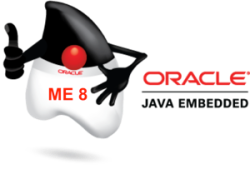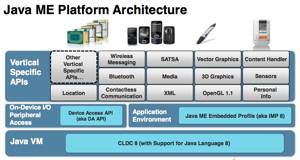You are currently browsing the tag archive for the ‘“jsr 361”’ tag.
Tag Archive
Java ME 8 Released!
04/30/2014 in Embedded | Tags: "Java ME 8", "jsr 360", "jsr 361", iot, Java 8, Java Embedded, Java ME Embedded 8, Java ME SDK 8, M2M, OJPI, release | 6 comments
Welcome to Java ME 8!
Last month, Java 8 was launched. Last week, the Java Micro Edition (ME) 8 specifications were approved.
Today, we are announcing the general availability (GA) of the Java ME 8 release.
This release is the culmination of a two-year effort driving a major update of the Java ME technology as a modern embedded software platform, purpose-built as a foundation for new services in the Internet Of Things. We are closely collaborating with industry partners and are seeing strong interest and adoption in Java ME 8 across a number of markets such as wireless modules, automotive, smart sensors, healthcare, industrial automation, smart energy, logistics, and others.
Top 10 Features of Java ME 8
Java ME 8 has been designed to enable advanced embedded software intelligence and increased product value for a wide range of use cases and solutions while maintaining very low system requirements. Top 10 features include:
- Aligned with Java 8 for efficient development
- Designed for Embedded
- Highly portable and scalable
- Consistent across devices
- Advanced application platform
- Modularized software services
- Client domain partitioning
- Direct access to hardware devices
- Compatible with standard APIs
- Enhanced embedded tooling
For more information, please see the screencast “Java ME 8: Top 10 Features”.
What We Are Releasing Today
Todays release comprises of several of components:
Java ME 8 TCK (Technology Compatibility Kit) and RI (reference implementation):
- Java ME Connected Limited Device Configuration (CLDC) 8 (JSR 360)
- Java ME Embedded Profile (MEEP) 8 (JSR 361)
Oracle Java ME Embedded 8 product implementations and tooling:
- Oracle Java ME Embedded 8 product implementations for several embedded platforms (see below)
- Oracle Java ME SDK (Software Development Kit) 8 for embedded software development
Oracle Java Platform Integrator (OJPI) releases for Java ME Embedded 8:
- Enables Oracle partners to deliver value-add products and services based on Java ME Embedded 8 (OJPI information)
Support for the following platforms:
- Raspberry Pi Model B (based on ARM11/Linux)
- Qualcomm IoE Development Platform (based on ARM9/Brew MP)
- Windows x86 device emulation environment (for rapid prototyping/development)
We are also planning on bringing Oracle Java ME 8 to additional platforms such as micro-controller-based devices – please stay tuned.
Where to Find More Information
For more information, please see the following links:
- Oracle Java ME Embedded 8 data sheet
- Oracle Java ME SDK 8 data sheet
- “Java ME 8 Deep Dive” technical presentation
- Java 8 Launch screencasts on Java ME 8 on a variety of different technical topics
- Java Magazine March issue with several articles on Java ME 8
- Video interviews with Oracle executives and Oracle partners on Java Embedded and IoT topics
- General information on Oracle’s Internet of Things Platform, including videos, white papers, and brochures
Getting Started with Java ME 8
To get started developing with Java ME 8, download the Oracle Java ME SDK 8 which comes with a built-in Java ME 8 device emulation environment for rapid development plus great documentation to get you started.
Once you’re ready to move on to real hardware such as Raspberry Pi or the Qualcomm IoE platform, download the ready-to-run Oracle Java ME Embedded 8 platform binaries.
Go here for the full set of Oracle Java ME 8 documentation, including:
- Release Notes
- Getting Started Guides for all platforms
- ME SDK Developer Guide
- Java ME Embedded Developer Guide
- API documentation
Finally, head over to the Java ME Embedded Forum to ask questions and get involved. And follow @javaembedded or @terrencebarr to stay in touch.
What Next?
Java ME 8 brings exciting new possibilities to the embedded software space. Get started today and stay tuned for more to come!
Cheers,
— Terrence
Java ME 8 Specifications Approved
04/27/2014 in Embedded | Tags: "Java ME 8", "jsr 360", "jsr 361", approval, CLDC 8, embedded, iot, Java ME Embedded, JCP, MEEP 8, microcontroller | 2 comments
About 18 months ago we embarked on an ambitious journey to deliver a major update of the Java ME platform standard by filing JSR 360 (CLDC 8) and JSR 361 (MEEP 8) in the JCP (“JSR 360 and JSR 361: A Big Leap for Java ME 8”).
Both JSR 360 and JSR 361 were unanimously approved this week, with 25 YES votes each. Java ME 8 is now a reality, bringing the power of Java 8 to small embedded. Stay tuned for more announcements soon.
In the meantime, for be sure to check out my webcast “Introduction to Java ME 8” or the ”Java ME 8 Deep Dive” presentation.
Cheers,
— Terrence
Accelerating to Java ME 8: CLDC 8 and MEEP 8 Public Review
08/28/2013 in Embedded | Tags: "Java ME 8", "jsr 360", "jsr 361", CLDC 8, Java Embedded, JCP | Leave a comment
As announced previously, Oracle is pushing Java ME forward in a big way:
Late last year, JSR 360 (CLDC 8) and JSR 361 (MEEP 8) were filed with the JCP (see: “A Big Leap For Java ME 8”). These two JSRs have been moving very quickly in the Expert Groups and I am happy to announce they are now in the Public Review stage (see the EG pages for JSR 360 and JSR 361).
Once approved, we will see start seeing updated Java ME-based products leveraging the new capabilities and features defined by CLDC 8 and MEEP 8, such as Java SE language/API alignment and a flexible, services-based embedded application platform. This will enable a new era for embedded Java scaling from very small microcontroller-based devices to more powerful, desktop-class embedded systems.
And not to forget, we also recently posted a proposal for updated Device Access API, which adds additional key capabilities in the embedded space for Java ME 8 platforms in terms of I/O and peripheral access.
Cheers,
— Terrence
JSR 360 and JSR 361: A Big Leap for Java ME 8
11/18/2012 in Mobile & Embedded | Tags: "jsr 360", "jsr 361", "me 8", embedded, Embedded Java, JCP | 9 comments
It might have gone unnoticed to some, but Java ME took a big leap forward a couple of weeks ago with the filing of two new JSRs:
- JSR 360: “Connected Limited Device Configuration 8” (aka CLDC 8)
- JSR 361: “Java ME Embedded Profile” (aka ME EP)
Together, these two JSRs will significantly update, enhance, and modernize the Java ME platform, and specifically small embedded Java, with a host of new features and functionality.
JSR 360 – Connected Limited Device Configuration 8
CLDC 8 is based on JSR 139 (CLDC 1.1) and updates the core Java ME VM, language support, libraries, and features to be aligned with Java SE 8. This will include:
- VM updated to comply with the JVM language specification version 2
- Support for SE 7/8 language features like Generics, Assertions, Annotations, Try-with-Resources, and more
- New libraries such as Collections, NIO subset, Logging API subset
- A consolidated and enhanced Generic Connection Framework for multi-protocol I/O
With CLDC 8, Java ME and Java SE are entering their next phase of alignment – making Java the only technology today that truly scales application development, code re-use, and tooling across the whole range of IT platforms, from small embedded to large enterprise.
JSR 361 – Java ME Embedded Profile
ME EP is based on JSR 228 (IMP-NG) and updates the specification in key areas to provide a powerful and flexible application environment for small embedded Java platforms, building on the features of CLDC 8:
- A new, lightweight component and services model
- Shared libraries
- Multi-application concurrency, inter-application communication, and event system
- Application management
- API optionality, to address low-footprint use cases
With ME EP, application developers will have a modern application environment which allows development and deployment of modular, robust, sophisticated, and footprint-optimized solutions for a wide range of embedded use cases and devices.
Summary
While these JSRs are still under development, it’s clear that there are exciting new times ahead for Java ME – turning into a serious application platform while maintaining the focus on resource-constrained devices to address the expected explosion of small, smart, and connected embedded platforms.
To learn more, click on the above links for JSR 360 and JSR 361. Or review the JavaOne 2012 online presentations on the topic:
Also, for more information on JSR 360, check out Roger Brinkley’s blog “A Look inside JSR 360”.
And stay tuned for more in this space!
Cheers,
— Terrence





Recent Comments